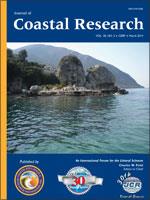Ali, A.; Lemckert, C.J.; Zhang, H., and Dunn, R.J.K., 2014. Sediment dynamics of a very shallow subtropical estuarine lake.
Estuaries are of immense importance to many communities. The characteristics of estuarine flow and sediment conditions are important, since they play a critical role in the functionality and health of these systems. This study investigated sediment dynamics of a very shallow subtropical estuarine system: Coombabah Lake, southern Moreton Bay (Australia). Total suspended solid concentrations, turbidity, salinity, and tide levels were measured at eight stations within the lake. In situ current velocity and meteorological data were also collected during the study period, and data were analysed to determine the dominant sediment dynamic processes within the lake. Sediment transport was simulated using a three-dimensional numerical model to better understand the influence of various physical processes. Influence of sea-level rise on the sedimentary dynamic processes was also examined. Results of the study identified that sediment dynamics were dominated by advection processes driven by the influence of tides, with wind and wave forcing playing minor roles during the study period. Model simulations agreed well with the collected field data. The influence of sea-level rise within the system was predicted to reduce the turbidity of the system, and presumably increase primary productivity.





